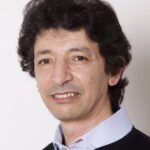Link to Pubmed [PMID] – 10655058
Nat. Genet. 2000 Feb;24(2):139-43
Genes specifically expressed in the inner ear are candidates to underlie hereditary nonsyndromic deafness. The gene Otog has been isolated from a mouse subtractive cDNA cochlear library. It encodes otogelin, an N-glycosylated protein that is present in the acellular membranes covering the six sensory epithelial patches of the inner ear: in the cochlea (the auditory sensory organ), the tectorial membrane (TM) over the organ of Corti; and in the vestibule (the balance sensory organ), the otoconial membranes over the utricular and saccular maculae as well as the cupulae over the cristae ampullares of the three semi-circular canals. These membranes are involved in the mechanotransduction process. Their movement, which is induced by sound in the cochlea or acceleration in the vestibule, results in the deflection of the stereocilia bundle at the apex of the sensory hair cells, which in turn opens the mechanotransduction channels located at the tip of the stereo-cilia. We sought to elucidate the role of otogelin in the auditory and vestibular functions by generating mice with a targeted disruption of Otog. In Otog-/- mice, both the vestibular and the auditory functions were impaired. Histological analysis of these mutants demonstrated that in the vestibule, otogelin is required for the anchoring of the otoconial membranes and cupulae to the neuroepithelia. In the cochlea, ultrastructural analysis of the TM indicated that otogelin is involved in the organization of its fibrillar network. Otogelin is likely to have a role in the resistance of this membrane to sound stimulation. These results support OTOG as a possible candidate gene for a human nonsyndromic form of deafness.



